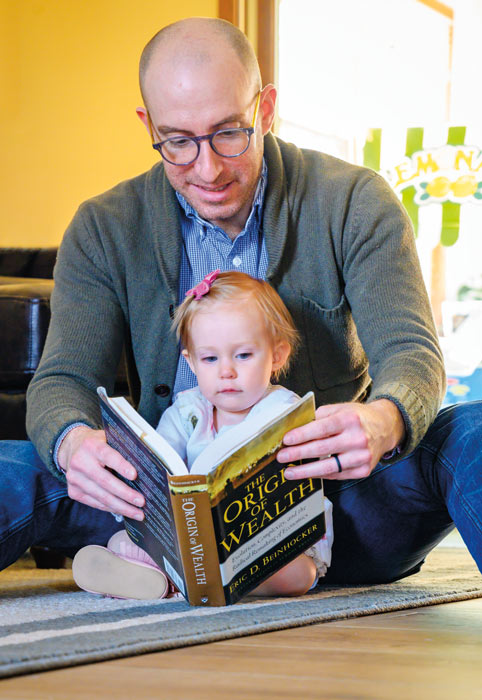NEVER TOO YOUNG TO LEARN
3 TIPS FOR TEACHING KIDS ABOUT INVESTING
 My daughter Elsie just turned 1. She can say Momma and Dadda, and her recent interests include learning to meow at the cat and blow kisses.
My daughter Elsie just turned 1. She can say Momma and Dadda, and her recent interests include learning to meow at the cat and blow kisses.
Elsie, however, is also an investor — kind of. She and her siblings Hazel (4) and Jason (3) have all been investors since birth, thanks to their GiGi and Pop-Pop, who set up a custodial investment account for each of them. By the time Elsie is 18, her portfolio could very well be worth north of $70,000.
As soon as I tell people I’m a finance professor at Notre Dame, I get one of two questions: “Got any hot stock tips?” and “How can I help my kids learn to invest?” I never have any hot stock tips, but I do have a pretty good answer for the second question.
At Notre Dame, I teach some of Mendoza’s brightest finance students in the College’s Applied Investment Management (AIM) course. The goal of AIM is to foster an environment where students can develop and sharpen their financial analyst skills. We accomplish this with a rigorous process of security analysis because we’re managing a live portfolio for Notre Dame roughly valued at $25 million. While these students are learning some sophisticated techniques for equity valuation and portfolio management, they are also learning lessons relevant to parents who want their kids to think about managing their money beyond merely saving for the next gaming system.
It is important to remember that the stock market doesn’t know who you are or what you do. Therefore, this strategy works for virtually everyone. You can be or do anything and still have a lot of success in accumulating wealth. It just takes patience, patience and discipline.
LESSON NO. 1:
THE SUPER POWER OF SLOW, STEADY INVESTING AND COMPOUND INTEREST
Yes, I’m aware of the 16-year-old kid who made $30,000 on GameStop during the stock’s recent short-selling rodeo ride. Good for all those GameStop investors, but that is just not normal (and most retail investors who bought at the height of the rally are still seeing negative returns in their portfolio. We won’t know the magnitude of losses until investors begin to sell).
The best investment strategy to teach your kids is also the least flashy — passive investing, where slow and steady investment wins the race. This race is a marathon though, not a sprint. What passive investing aims to do is earn the market return, each and every year. Over the course of this marathon, you’re earning on average 10% per year. That means your initial $10 investment becomes $11 next year, and then $12.10, $13.31 and $14.64 after that. In four years, that’s not 40% return but a 46% return!
The seemingly magical effect of compound interest is one of the first principles of investing to teach your kids. Even though the return is 10% each year, the initial investment grows larger and larger and larger.
Through much of the 1980s and 1990s, active investing was the mainstay where an investor (or an investment professional) hand-picked stocks with the aim of generating returns above the market benchmark. The problem is that research clearly shows that when active management fees are factored in, active investors underperform broad market returns over time. Since the late 1990s, most retail investing has been reallocated to what we call passive investing. Anyone with a 401(k) or 403(b) is familiar with mutual funds, which are institutional portfolios made from a basket of stocks that can track almost any index, such as the Dow Jones Industrial Average, the S&P 500, the Nasdaq, or even a sub-sector of an index like tech stocks.
Passive investing is extremely popular for a good reason — it’s a lot cheaper than active investing and you typically earn what the market returns. And here is where the miracle of compound interest works in your favor. It’s very much a set-it-and-forget-it way to invest, and if you start your kids’ portfolio early, it can significantly shape their future wealth.
For example, let’s say that you set up a fund for your child and initially contribute $1,000 and then $50 every month to the portfolio. If you earn only market returns of about 10%, by the time the child is 30, the portfolio is worth about $116,000. If she invests $50 contributions each month and lets the fund sit until she’s ready to retire at 68 or so, the value is up to about $4.5 million. That’s what we mean by time and patience and discipline — just contributing when you can and letting it sit and grow.
LESSON NO. 2:
YOU ARE NOT WARREN BUFFET (BUT YOU CAN LEARN FROM HIS STRATEGY)
 There are definitely investors who feel that they can beat the market, and some do, but it is extremely difficult to do so consistently. Investors who consistently beat the market are called outliers. Warren Buffett is an outlier. But when we look at what he actually does, we find him to be a great inspiration for what we teach here in the finance department, which is the concept of value investing — or buying a stock that is undervalued by the market.
There are definitely investors who feel that they can beat the market, and some do, but it is extremely difficult to do so consistently. Investors who consistently beat the market are called outliers. Warren Buffett is an outlier. But when we look at what he actually does, we find him to be a great inspiration for what we teach here in the finance department, which is the concept of value investing — or buying a stock that is undervalued by the market.
With AIM students, in order to find undervalued stocks, we first teach students to strip away all of the math, all the analytic formulas and frameworks, and focus on one central question: Do we believe in this company? Do we believe in the business, what product or service it provides? Do we believe that there’s going to be strong tailwinds to make sure that they can continue generating revenue?
Warren Buffet only invests in what he knows. Often, our AIM students come into the class thinking that they will learn to manage a portfolio by using algorithmic or quant trading, which are highly sophisticated, analytics-based methods of trading. However, they leave AIM understanding that we care about investing in good businesses.
To all you parents out there, I sympathize and understand that after running around with your kids all day, you likely won’t have the time to construct your own portfolio like Warren Buffet. But remember, with disciplined, steady investments in a passive mutual fund, you can still build significant wealth.
And when you find a spare moment, look at choosing one or two equities in a company that your child enjoys or believes in. Do this once or maybe twice a year and then rinse and repeat for 18 more! As I said, this isn’t a flashy strategy and it does take discipline, but it is meant to allow individuals to accumulate wealth.
LESSON NO. 3:
GAINING TO GIVE BACK
Even as passive investors, we can make choices about our investment philosophy. Encouraging kids to think about how they can use wealth to make a difference in the world instills a value-investing mindset that takes money management to the next level.
Recently, new funds have been created that target companies that fit an Environmental, Social and Governance (ESG) framework. Each fund uses a common but unique selection process to invest in companies that are stewards of the environment or foster partnerships with employees and suppliers, and that focus on company leadership and accountability. Investors can explore a variety of funds that fit with their internal compass, but they also get to pass along the due diligence to professional wealth managers.
As my three kids get older and learn more about the world and their community, we’re surely to have conversations surrounding environmental stewardship, accountability or community impacts. Now, with the rise of ESG funds, we will be able to add an additional layer to our money management and investing conversations.
So that’s it. That’s the not-so-secret secret to creating wealth — patience, patience and discipline. Start early and contribute when you can. If you’re ever short on inspiration, always come back to the proverb: The best time to plant a tree is 20 years ago. The second best time is now. The same is true for investing.
Photo by Matt Cashore (ND '94).
JASON REED is the Wade Family Assistant Teaching Professor of Finance; Assistant Department Chair, Director of Undergraduate Studies in the Finance Department.

Comments